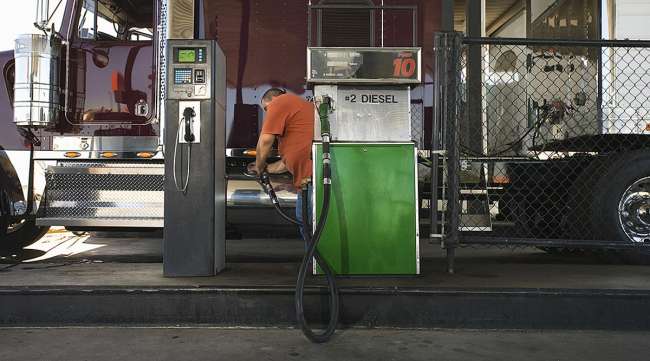Senior Reporter
Diesel Rises 0.9¢ for Second Consecutive Gain

The U.S. average retail price of diesel rose 0.9 cent to $2.481 amid a record surge in refinery production of distillate fuel — which includes ultra-low-sulfur diesel — and a slow rebound in oil prices after they dropped sharply a week earlier, analysts said.
Diesel now costs 6.7 cents more than it did a year ago, when the price was $2.414 a gallon, the Department of Energy said July 10. It marked diesel’s second increase after four consecutive weekly declines.
Distillate production totaled more than 5.3 million barrels per day for the week ending July 7, DOE’s Energy Information Administration said.
“I believe that’s a record, 5.349 [million barrels] for distillates,” Denton Cinquegrana, chief oil analyst at Oil Price Information Service, told Transport Topics.
“Crude oil production is kind of a diesel-intensive process, so with U.S. crude oil production moving up, it makes sense distillate demand is pushing higher as well,” he added.
Regional prices for trucking’s main fuel rose in seven markets and were unchanged in two others, while in the Rocky Mountain region, diesel price declined by 0.1 cent.
With oil prices in the mid-$40 range, it’s unlikely diesel prices “will get too crazy despite the fact you have pretty solid demand compared with last year,” Cinquegrana said.
Over the previous four weeks, distillate fuel product supplied, an indication of demand, averaged 4.1 million barrels per day, up 8.8% compared with the same period last year, EIA said.
As the summer driving season got underway, the U.S. average price for regular gasoline jumped 3.7 cents to $2.297 a gallon, the first increase in four weeks. The cost is 4.4 cents more than it was a year ago, EIA said.
Refinery production of gasoline increased to about 10.5 million barrels a day for the week ending July 7, EIA said.
Meanwhile, West Texas Intermediate crude futures on the New York Mercantile Exchange closed at $44.40 per barrel July 10, compared with $47.07 on July 3.
“Excess supply [of oil] is still what’s controlling market prices,” Rob Haworth, senior investment strategist at U.S. Bank Wealth Management in Seattle, which oversees $142 billion of assets, told Bloomberg News.
That means oil prices are likely to remain low.
“I suspect oil prices will remain weak through the end of the calendar year,” Jeffrey Born, professor of finance at Northeastern University, told TT. “I don’t see them rising and sticking above $50 for very long.”
The good news for trucking is energy prices “are far more likely to go lower than go significantly higher,” he said.
Moreover, the OPEC cartel is unstable, and cheating on production quotas among its members occurs while many nonmembers, including Russia and now the United States, “march to their own drummers,” Born said.
Another wild card is the recent royal shuffle in Saudi Arabia, where Mohammed bin Salman ousted the former crown prince Mohammed bin Naye, he said.
“There is always the possibility of a price war amongst the big oil producers,” Born said. “The Saudis previously signaled that they were not going to continue this strategy [of lower production quotas] in an effort to drive U.S. shale gas producers out of business. This is where the political shake-up comes into play. The sacking of the [previous] crown prince might be a signal that Saudi policy is about to change,”
In the meantime, at some point this summer, Cinquegrana expects to see a new record for gross inputs [crude oil and other feedstocks] running to the refineries. “I think the record was set right before Memorial Day weekend, and this past week was not far off,” he said.
U.S. crude oil refinery inputs averaged more than 17.2 million barrels per day during the week ending July 7, or 103,000 barrels per day more than the average in the previous week, as refineries operated at 94.5% of their operable capacity, EIA said.
“Refining margins are not great, but they are certainly adequate for refiners to continue to run,” Cinquegrana said.
The weekly U.S. rig count also rose to 952 during the week of July 7, or 12 more than the week before and 512 more than a year earlier, oil field services company Baker Hughes Inc. reported.
Houston-based Baker Hughes ranks No. 14 on the Transport Topics Top 100 list of the largest private carriers in North America.




